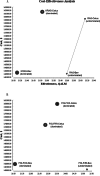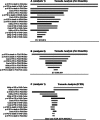Economic evaluation study (CHEER-compliant): Cost-effectiveness analysis of RAS screening for treatment of metastatic colorectal cancer based on the CALGB 80405 trial
- PMID: 27399059
- PMCID: PMC5058788
- DOI: 10.1097/MD.0000000000003762
Economic evaluation study (CHEER-compliant): Cost-effectiveness analysis of RAS screening for treatment of metastatic colorectal cancer based on the CALGB 80405 trial
Abstract
Cetuximab (Cetux)/Bevacizumab (Bev) treatments have shown considerably survival benefits for patients with metastatic colorectal cancer (mCRC) in the last decade. But they are costly. Currently, no data is available on the health economic implications of testing for extended RAS wild-type (wt) prior to Cetux/Bev treatments of patients with mCRC. This paper aimed to evaluate the cost-effectiveness of predictive testing for extended RAS-wt status in mCRC in the context of targeting the use of Cetux/Bev.Markov model 1 was conducted to provide evidence evaluating the cost-effectiveness of predictive testing for KRAS-wt or extended RAS-wt status based on treatments of chemotherapy plus Cetux/Bev. Markov model 2 assessed the cost-effectiveness of FOLFOX plus Cetux/Bev or FOLFIRI plus Cetux/Bev in extended RAS-wt population. Primary base case data were identified from the CALGB 80405 trial and the literatures. Costs were estimated from West China Hospital, Sichuan University, China. Survival benefits were reported in quality-adjusted life-years (QALYs). The incremental cost-effectiveness ratio (ICER) was calculated.In analysis 1, the cost per QALY was $88,394.09 for KRAS-Cetux, $80,797.82 for KRAS-Bev, $82,590.72 for RAS-Cetux, and $75,358.42 for RAS-Bev. The ICER for RAS-Cetux versus RAS-Bev was $420,700.50 per QALY gained. In analysis 2, the cost per QALY was $81,572.61, $80,856.50, $80,592.22, and $66,794.96 for FOLFOX-Cetux, FOLFOX-Bev, FOLFIRI-Cetux, and FOLFIRI-Bev, respectively. The analyses showed that the extended RAS-wt testing was less costly and more effective versus KRAS-wt testing before chemotherapy plus Cetux/Bev. Furthermore, FOLFIRI plus Bev was the most cost-effective strategy compared with others in extended RAS-wt population.It was economically favorable to identify patients with extended RAS-wt status. Furthermore, FOLFIRI plus Bev was the preferred strategy in extended RAS-wt patients.
Conflict of interest statement
The authors have no funding and conflicts of interest to disclose.
Figures



Similar articles
-
Cost-Effectiveness Analysis of First-Line FOLFIRI Combined With Cetuximab or Bevacizumab in Patients With RAS Wild-Type Left-Sided Metastatic Colorectal Cancer.Cancer Control. 2020 Jan-Dec;27(1):1073274820902271. doi: 10.1177/1073274820902271. Cancer Control. 2020. PMID: 32107929 Free PMC article. Clinical Trial.
-
Cost-effectiveness of FOLFIRI + cetuximab vs FOLFIRI + bevacizumab in the first-line treatment of RAS wild-type metastatic colorectal cancer in Germany: data from the FIRE-3 (AIO KRK-0306) study.J Med Econ. 2020 May;23(5):448-455. doi: 10.1080/13696998.2019.1709848. Epub 2020 Jan 17. J Med Econ. 2020. PMID: 31903807
-
Cost-effectiveness analysis of cetuximab combined with chemotherapy as a first-line treatment for patients with RAS wild-type metastatic colorectal cancer based on the TAILOR trial.BMJ Open. 2020 Feb 12;10(2):e030738. doi: 10.1136/bmjopen-2019-030738. BMJ Open. 2020. PMID: 32051297 Free PMC article. Clinical Trial.
-
The Clinical and Cost Effectiveness of Aflibercept in Combination with Irinotecan and Fluorouracil-Based Therapy (FOLFIRI) for the Treatment of Metastatic Colorectal Cancer Which has Progressed Following Prior Oxaliplatin-Based Chemotherapy: a Critique of the Evidence.Pharmacoeconomics. 2015 May;33(5):457-66. doi: 10.1007/s40273-015-0257-z. Pharmacoeconomics. 2015. PMID: 25616671 Review.
-
Economic Evaluation of Monoclonal Antibodies in Metastatic Colorectal Cancer: A Systematic Review.Mol Diagn Ther. 2021 Nov;25(6):715-734. doi: 10.1007/s40291-021-00560-4. Epub 2021 Nov 24. Mol Diagn Ther. 2021. PMID: 34816395
Cited by
-
Conventional colon adenomas harbor various disturbances in microsatellite stability and contain micro-serrated foci with microsatellite instability.PLoS One. 2017 Feb 24;12(2):e0172381. doi: 10.1371/journal.pone.0172381. eCollection 2017. PLoS One. 2017. PMID: 28234922 Free PMC article.
-
Cost-effectiveness analysis of selective first-line use of biologics for unresectable RAS wild-type left-sided metastatic colorectal cancer.Curr Oncol. 2019 Oct;26(5):e597-e609. doi: 10.3747/co.26.4843. Epub 2019 Oct 1. Curr Oncol. 2019. PMID: 31708653 Free PMC article.
-
Do cancer biomarkers make targeted therapies cost-effective? A systematic review in metastatic colorectal cancer.PLoS One. 2018 Sep 26;13(9):e0204496. doi: 10.1371/journal.pone.0204496. eCollection 2018. PLoS One. 2018. PMID: 30256829 Free PMC article.
-
Using Genomic Heterogeneity to Inform Therapeutic Decisions for Metastatic Colorectal Cancer: An Application of the Value of Heterogeneity Framework.Appl Health Econ Health Policy. 2025 May;23(3):441-452. doi: 10.1007/s40258-024-00926-9. Epub 2024 Nov 9. Appl Health Econ Health Policy. 2025. PMID: 39520611
-
Cost-Effectiveness Analysis of First-Line FOLFIRI Combined With Cetuximab or Bevacizumab in Patients With RAS Wild-Type Left-Sided Metastatic Colorectal Cancer.Cancer Control. 2020 Jan-Dec;27(1):1073274820902271. doi: 10.1177/1073274820902271. Cancer Control. 2020. PMID: 32107929 Free PMC article. Clinical Trial.
References
-
- Winder T, Lenz HJ. Vascular endothelial growth factor and epidermal growth factor signaling pathways as therapeutic targets for colorectal cancer. Gastroenterology 2010; 138:2163–2176. - PubMed
-
- Parks R, Gonen M, Kemeny N, et al. Adjuvant chemotherapy improves survival after resection of hepatic colorectal metastases: analysis of data from two continents. J Am Coll Surg 2007; 204:753–761. - PubMed
-
- Ferrara N, Gerber HP, LeCouter J. The biology of VEGF and its receptors. Nat Med 2003; 9:669–676. - PubMed
-
- Welch S, Spithoff K, Rumble RB, et al. Grp GCDS. Bevacizumab combined with chemotherapy for patients with advanced colorectal cancer: a systematic review. Ann Oncol 2010; 21:1152–1162. - PubMed
MeSH terms
Substances
LinkOut - more resources
Full Text Sources
Other Literature Sources
Medical

